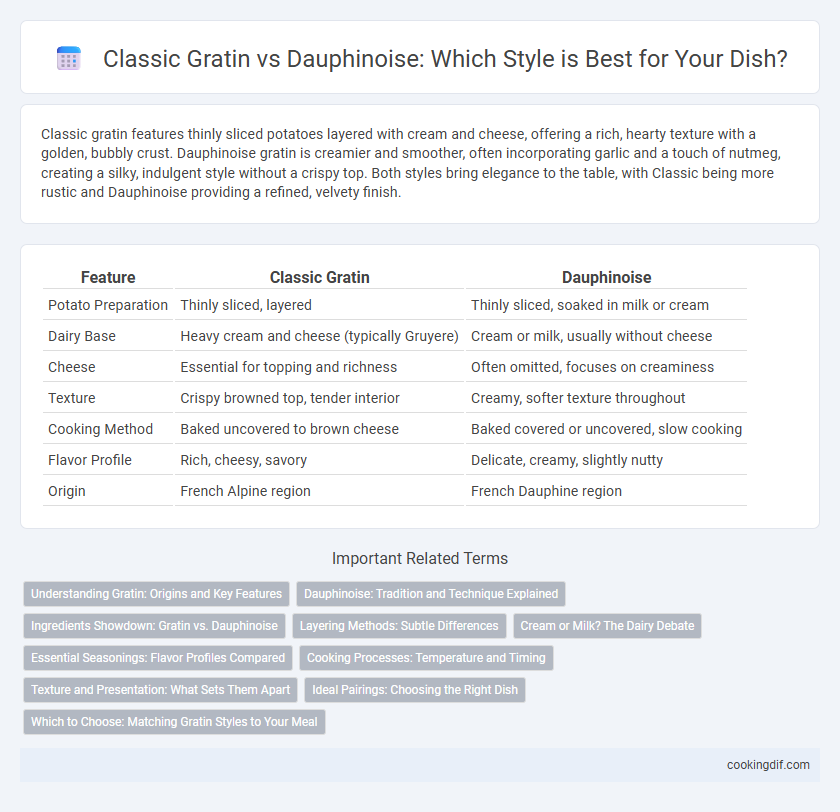Classic gratin features thinly sliced potatoes layered with cream and cheese, offering a rich, hearty texture with a golden, bubbly crust. Dauphinoise gratin is creamier and smoother, often incorporating garlic and a touch of nutmeg, creating a silky, indulgent style without a crispy top. Both styles bring elegance to the table, with Classic being more rustic and Dauphinoise providing a refined, velvety finish.
Table of Comparison
| Feature | Classic Gratin | Dauphinoise |
|---|---|---|
| Potato Preparation | Thinly sliced, layered | Thinly sliced, soaked in milk or cream |
| Dairy Base | Heavy cream and cheese (typically Gruyere) | Cream or milk, usually without cheese |
| Cheese | Essential for topping and richness | Often omitted, focuses on creaminess |
| Texture | Crispy browned top, tender interior | Creamy, softer texture throughout |
| Cooking Method | Baked uncovered to brown cheese | Baked covered or uncovered, slow cooking |
| Flavor Profile | Rich, cheesy, savory | Delicate, creamy, slightly nutty |
| Origin | French Alpine region | French Dauphine region |
Understanding Gratin: Origins and Key Features
Classic gratin, originating from French culinary traditions, is characterized by its golden, crispy cheese or breadcrumb crust that enhances layered ingredients such as potatoes or vegetables. Dauphinoise gratin, specifically from the Dauphine region, features thinly sliced potatoes baked in cream and garlic without the cheese topping, emphasizing a rich and creamy texture. Understanding these distinctions highlights how classic gratin focuses on a crunchy surface and robust flavor, while Dauphinoise prioritizes smoothness and subtle seasoning.
Dauphinoise: Tradition and Technique Explained
Dauphinoise potatoes showcase a rich French culinary tradition characterized by thinly sliced potatoes baked slowly in cream or milk, often with garlic and nutmeg, creating a silky texture and deep flavor. Unlike the simpler gratin style that primarily relies on cheese and potatoes, Dauphinoise demands a careful layering technique and precise temperature control to achieve its signature tender yet cohesive consistency. Mastery of this technique highlights the dish's heritage from the Dauphine region, emphasizing slow cooking to meld flavors while maintaining an elegant presentation.
Ingredients Showdown: Gratin vs. Dauphinoise
Classic gratin features thinly sliced potatoes baked with cream, cheese, and breadcrumbs, delivering a rich, crispy top layer that contrasts with tender potatoes beneath. Dauphinoise relies on layered raw potatoes soaked in garlic-infused cream, baked slowly without cheese, resulting in a silky texture and pronounced garlic flavor. The ingredients highlight the gratin's cheesy, crunchy appeal versus the dauphinoise's smooth, aromatic creaminess.
Layering Methods: Subtle Differences
Classic gratin features thinly sliced potatoes layered uniformly with cheese and cream, creating distinct, visible layers that melt harmoniously during baking. Dauphinoise uses a similar layering approach but emphasizes soaking potatoes in garlic-infused cream before layering, resulting in a creamier texture and more integrated flavors. The subtle differences in layering techniques affect the gratin's overall consistency, with the Classic retaining firmer layers while Dauphinoise achieves a smoother, more cohesive dish.
Cream or Milk? The Dairy Debate
Classic gratin recipes typically favor heavy cream for a rich, velvety texture and indulgent flavor, creating a luxurious, browned crust. Dauphinoise potatoes traditionally use milk or a combination of milk and cream, resulting in a lighter, creamier consistency with subtle dairy notes. The choice between cream or milk directly influences the dish's richness, mouthfeel, and overall decadence, shaping the gratin's signature style.
Essential Seasonings: Flavor Profiles Compared
Classic gratin relies heavily on nutmeg and garlic to elevate its creamy, cheesy base, creating a comforting and mildly spiced flavor profile. Dauphinoise gratin, on the other hand, emphasizes simplicity with subtle hints of thyme and bay leaf, allowing the natural sweetness of the potatoes to shine through. Both styles balance richness with essential seasonings, but the classic version offers a more robust, aromatic experience while Dauphinoise leans towards delicacy and herbaceous refinement.
Cooking Processes: Temperature and Timing
Classic gratin is baked at a moderate temperature around 350degF (175degC) for about 45 minutes to develop a golden, bubbling crust with tender layers underneath. Dauphinoise requires a slower cooking process at a lower temperature near 300degF (150degC) for up to 1 hour, allowing the cream and cheese to meld deeply with thinly sliced potatoes. Precise temperature control and timing are crucial for achieving the perfect texture: crispy on top for classic, smooth and creamy throughout for Dauphinoise.
Texture and Presentation: What Sets Them Apart
Classic gratin features thinly sliced potatoes baked with cheese and cream, resulting in a rich, golden crust with a tender interior that boasts a slightly crispy top layer. Dauphinoise potatoes, typically prepared without cheese, rely on cream infused with garlic and herbs for a smooth, velvety texture marked by a delicate, creamy consistency and a pale, elegant presentation. The key difference lies in texture: gratin offers a robust, crunchy surface, while Dauphinoise provides a more refined, melt-in-the-mouth experience.
Ideal Pairings: Choosing the Right Dish
Classic gratin features thinly sliced potatoes baked with cream and cheese, offering a rich, hearty texture perfect alongside roasted meats or robust salads. Dauphinoise gratin uses slow-cooked potatoes with garlic and cream, creating a creamy, delicate flavor ideal for pairing with poultry or light vegetable dishes. Selecting between Classic and Dauphinoise gratin depends on desired richness and harmony with main course flavors.
Which to Choose: Matching Gratin Styles to Your Meal
Classic gratin features thinly sliced potatoes layered with cream, garlic, and cheese, creating a rich, hearty dish that pairs well with roasted meats and rustic meals. Dauphinoise gratin emphasizes a lighter texture using cream and milk, often without cheese, offering a delicate, silky side ideal for refined poultry or fish dishes. Choose classic gratin for robust, comforting flavors, and dauphinoise when a subtle, elegant accompaniment enhances your meal's overall balance.
Classic vs Dauphinoise for style Infographic

 cookingdif.com
cookingdif.com